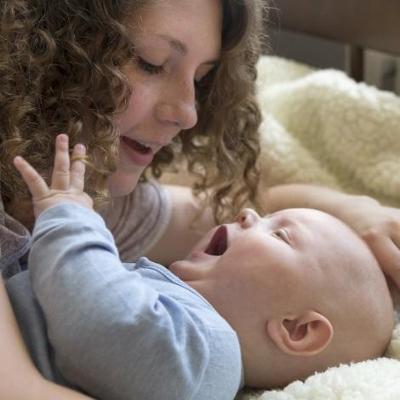Best for babies

Try these home play ideas to support early talk.
Play hiding games
Try playing games like "peek-a-boo". With little babies 0-6 months old, sit facing your baby and then hide your face with a piece of material. Then slowly and gently pull the material away - smile and say "Peek-a-boo!". Use gentle movements and a soft voice as little babies can startle easily.
You might also want to try partially hiding your child's favourite toy under the material - watch to make sure your baby is enjoying the game when you remove the fabric. Continue if they are smiling and happy.
Why is this important? - This teaches your baby important skills like turn-taking, paying attention and listening. This type of play is fun and makes your baby feel happy and excited.
More ideas for talking and playing with babies
Share a book
Babies often like to snuggle up close and listen to the sound of your voice, so it is never too early to start sharing books.
New-born babies are able to see books with black-and-white patterns best. As they get a little bit older, try board books with simple pictures and a few words, as well as 'touchy-feely' books. Let your baby hold the book and turn the pages (don't worry if they put the book in their mouths).
Remember, you don't have to read the words on the page, just talk to your baby about what you can see. Your baby will enjoy the book even more if you use funny voices and sound effects.
This is a good time to start taking your baby to a local library, books are free to borrow, and the library staff will understand if the book gets sucked or chewed!
Why is this important? - Reading to your baby helps you both feel close. Your baby will learn lots of new words and sounds which will help them to make sense of the world through stories.
More information about reading with babies
Out and about
When you are outdoors your baby can feel the wind, try lying under a tree to watch the branches moving.
When you are walking with your baby in a buggy, try stopping to show them things. Many buggies are forward facing so go around to the front, get down to your baby's level and talk about what you can see.
When at a supermarket, your baby can sit in a trolley so you can be face-to-face. Show your baby what you are picking up, and talk about it - watch your baby's facial expressions, return their smiles and copy their noises.
Why is this important? - Babies need to feel safe to explore and make sense of the outside world. They like to see their parents' responses to new things, so that they know how to respond, and you can give them new words to describe all they see and experience.
Research about talking with babies in buggies

